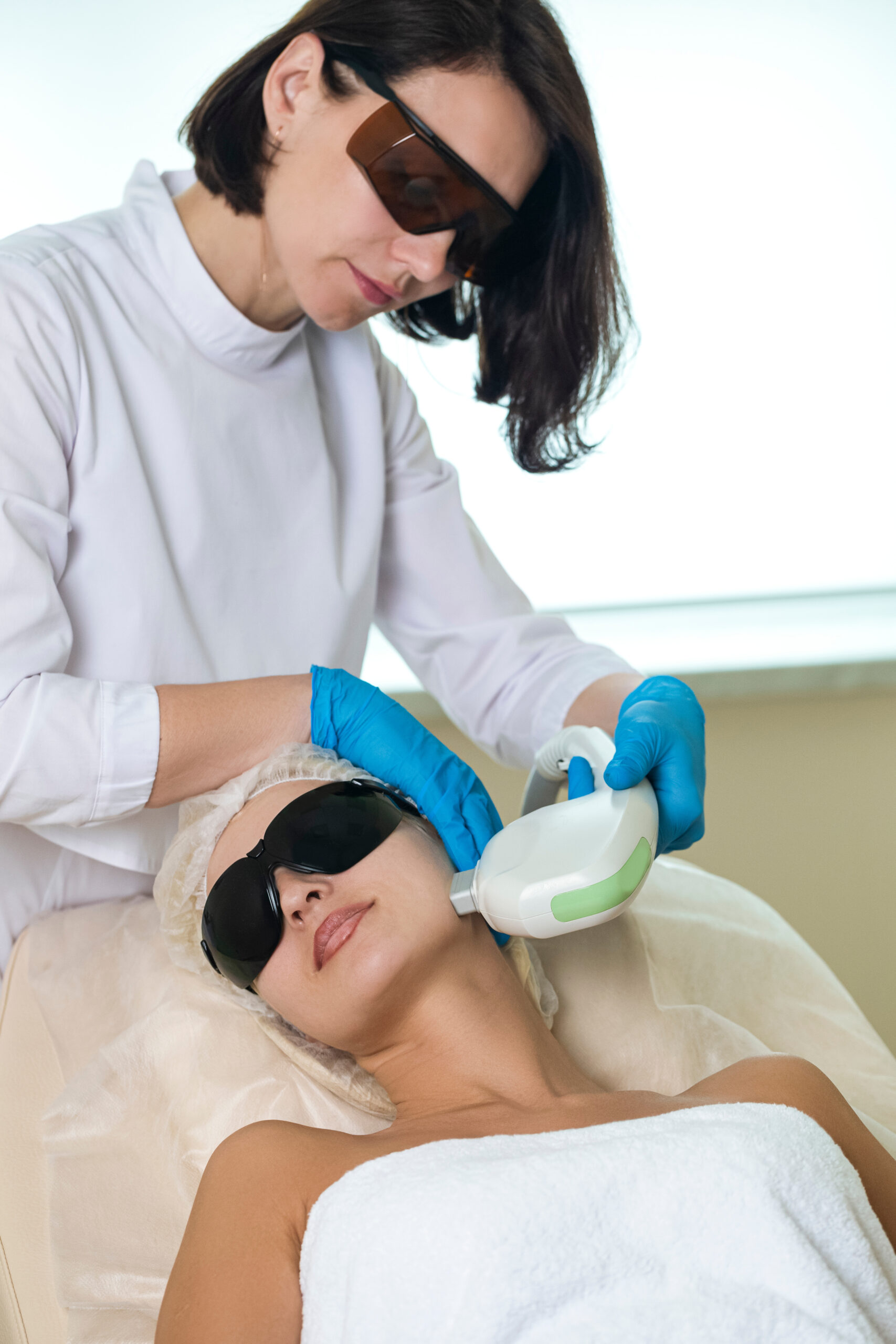
What Are The Top 10 Long Term IPL Facial Benefits
At some point in time, most people, including myself, have found themselves examining their skin and wondering how they can improve their complexion.
There are so many skin care products and intense medical treatments like chemical peels and laser resurfacing procedures out there. With all of them promising you the best results, it’s hard to know what the best option is for you and your particular needs. One of the top non-invasive skin rejuvenation options is IPL (Intense Pulsed Light) therapy, and for a good reason. It’s been proven to roll back the visible signs of aging skin, like the appearance of fine lines and wrinkles, as well as the effects of sun damage, with minimal downtime. And as far as medical procedures go, IPL skin rejuvenation is fairly manageable in cost.
Let’s go over all of the long-term benefits of IPL facial therapy, what to expect from a photofacial, and find out if light therapy is the right treatment for you.
10 Long-Term IPL Facial Benefits
Minimizes Fine Lines And Wrinkles
An IPL photofacial can help reduce signs of aging, like fine lines and the appearance of wrinkles. These laser treatments are able to treat deeper layers of the skin, which stimulates new collagen production. The result is fewer wrinkles and tighter, smoother beautiful skin.
Reduces Skin Discoloration
Photofacial treatments also address skin discoloration like age spots and sun spots from too much sun exposure. When combined with topical creams, IPL therapy can also help treat pigmentation issues caused by skin conditions like melasma. In some cases, light therapy can actually make melasma worse, so your dermatologist will first thoroughly assess your skin type before recommending IPL.
It Helps Control Acne And Improve Acne Scars
Most of us have experienced acne at some point in time, and if you haven’t, you are part of the lucky minority. Fortunately, acne issues tend to go away on their own sometime between the late teenage and early adult years. For those that are still struggling with severe acne, IPL skin treatments can help. Light treatments help destroy certain acne bacteria, paralyze overactive oil glands, and combat redness, inflammation, discoloration, and scarring.

Tightens And Smooths The Skin
A typical sign of aging and one of the biggest skin concerns as we grow older is loose skin. That’s because collagen production slows down as we age, and the skin begins to thin. The result is wrinkles and loose skin. IPL photorejuvenation stimulates collagen-producing skin cells, which help plump the skin and give it a more youthful appearance.
Reduces Skin Redness
Rosacea is a common long-term inflammatory skin condition that causes intense flushing or reddening of the face. Although not as common, blushing or red spots occasionally appear on other areas of the body, like the neck and chest. IPL treats rosacea by using controlled light pulses in specific wavelengths to effectively alleviate inflammation and redness.
It Gets Rid Of Small Broken Blood Vessels
Broken capillaries and spider veins are actually dilated blood vessels beneath your skin. These small blood vessels usually appear in the facial area where the skin is thinnest, like around the eyes, nose, and cheeks. The most common cause of ‘broken’ capillaries is chronic, long-term sun exposure. A good vitamin C serum can help reduce redness and strengthen your capillaries. But the most efficient way to actually get rid of them is with an in-office laser therapy treatment.
Remove Birthmarks
IPL therapy is an effective way to remove various types of birthmarks, including port wine stains, cafe au lait spots, salmon patches, mongolian spots, and stork bites. Light therapy treatment progressively shrinks the blood vessels causing the birthmark to fade gradually. Depending on the type of birthmark, treatment progressively shrinks the blood vessels, or the unwanted pigment darkens for a short time then gradually fades. Laser therapy may not be an option for individuals with darker skin tones because it can cause hyperpigmentation and actually make the problem worse.

Minimize The Size Of Pores
IPL treatments rejuvenate the skin by stimulating new collagen growth, as well as reducing the amount of oil production which can clog pores. One of the biggest benefits of IPL treatments is the increased production of collagen. The result is better skin tone, and the look of large pores will gradually reduce in size.
Improves Skin Texture
Photofacials help improve the skin’s texture from the bottom up. Light therapy penetrates deeper layers of the skin, promoting collagen growth. Collagen helps promote skin elasticity and firmness, and rough, uneven skin is gradually replaced with new skin for a healthier and more youthful texture.
Reduces The Signs Of Aging
Although aging is a natural part of life, there’s nothing wrong with wanting to look your best. And when it comes to skincare, it’s much easier to take good preventative measures than to try and fix things later. You can read about the first signs of skin aging and the steps you can take to combat them here: What Are The First Signs of Skin Aging
If you’re looking for a cosmetic procedure that will help you achieve younger-looking skin, you should consult your dermatologist about IPL. Because it works so well at treating all of the above skin issues, IPL photofacial treatments are one of the most effective ways of attaining dramatic results with little recovery time.

What is an IPL Photofacial
IPL photofacials are non-invasive facial treatments that use powerful bursts of light to improve the appearance of the skin. The light energy goes beyond the superficial layers of the skin and causes controlled microscope injuries. The body naturally begins healing itself by creating new cells and ramping up collagen production.
When used for treating acne, the light penetrates through layers of skin and destroys the acne-causing bacteria. It also reduces oil production, which oftentimes characterizes bad acne.
IPL treatments can also be used for hair removal and permanent hair reduction anywhere on the body, although multiple sessions are required.
IPL vs. Laser Treatment
Traditional laser treatments use a single type of light which creates a specific target when treating your skin. Intense Pulsed Light therapy, on the other hand, uses a beam of broad-spectrum light. These wavelengths are more gentle, safer to use on sensitive skin, and can target several problems at the same time.
Who Is The Ideal Candidate For An IPL Facial
IPL is for people looking to improve the look of brown spots, sun damage, redness, and rosacea. As well as acne, enlarged pores, fine lines, and wrinkles. The downside is that it works best on people with light to medium complexions and is not recommended for people with darker skin tones.
I have had one photofacial before at a small well known medspa. But when I spoke to my dermatologist about it, I was told my own skin tone was too dark and was advised never to do it again. The point in saying this is to make sure you see a professional you trust!
How Much Does A IPL Facial Cost
An IPL photofacial cost, on average, typically ranges from $350 to $650 per session. Depending on the size of the treatment area and the professional you choose to visit, the cost can rise to $1,000.
Number Of Treatments Required
The number of sessions required to achieve your desired results will depend on the severity of your skin conditions. Some people may be happy with only 1-2 sessions. However, most people require 2-5 sessions spaced four weeks apart to achieve optimal results.

What To Expect During IPL Treatment
At the start of your IPL procedure, a cooling gel is applied to the skin’s surface, covering the treatment area. Then you’ll be handed a pair of dark glasses to protect your eyes. A dermatologist or skin care specialist will use a handheld device and press it onto the skin to emit an intense light pulse. The IPL device is moved along the skin surface, with new intense pulses of light emitted at each point until the entire area is treated. Treatments typically last around 30-45 minutes, depending on the size of the treatment area. Once finished, the cool gel is wiped clean, and you’re done.
Most people only feel a stinging sensation similar to a rubber band snap. If you have sensitive skin or are worried about feeling any discomfort, applying a topical anesthetic to the treated area beforehand can significantly reduce this.
Recovery And Aftercare
To achieve the best results from your photofacial, you should take some preventative measures several weeks before your first treatment. You should avoid tanning or excessive sun exposure and be sure to use SPF when outdoors.
Immediately after your treatment, your face will feel hot and sensitive, similar to a mild sunburn. However, this should mostly subside within a few hours. Your dermatologist will review aftercare instructions with you which you should carefully follow. Although downtime is minimal, for at least the next two days, you may need to alter your daily activities. You should avoid all direct sunlight, hot water, and saunas, or you could risk damaging sensitive skin. For optimal results, you should wear a minimum SPF 30 for the next six weeks. Wearing a large-brim hat if you’re spending time outdoors is even better.
How Soon Until You See The Results Of Your Photofacical?
You should see the initial results of an IPL treatment, including an improvement in the texture of your skin after one week. After four to six weeks, you will see the final results of a given session. You may need more than one session to reach your desired result.
Side Effects Of IPL
Some of the most common IPL photofacial side effects are redness and swelling. Freckles and brown spots may appear darker, or you may notice some light patches on the skin. Although they can be unpleasant, most side effects are temporary and usually resolve within a week.
Who Should Not Do IPL Therapy
IPL therapy is not for everyone. Pregnant women, and those that are sensitive to light, have very dark skin, use topical retinoid creams, have recently been tanning, or possibly have skin cancer, then it probably isn’t an option for you.
Depending on your skin type and goals, a chemical peel or a PRF microneedling facial may be better options. Of course, this is something that a professional will be able to help you decide.
If You Found This Post Helpful, You May Also Enjoy These Other Beauty Related Topics

